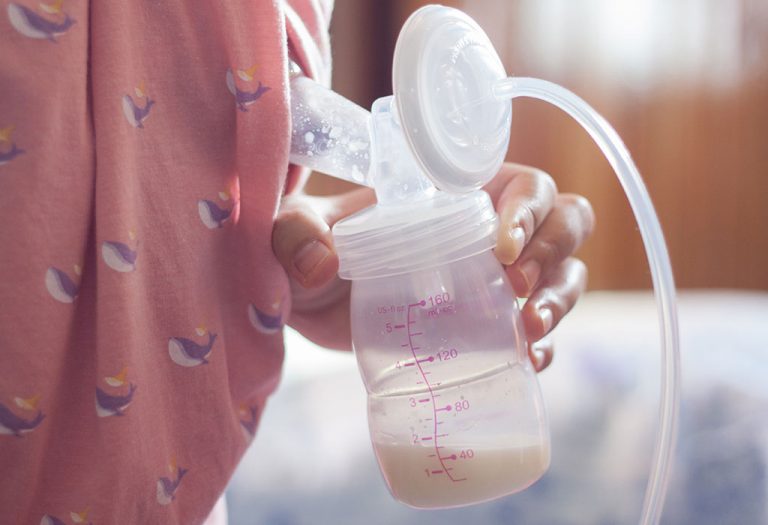Relactation – How to Start Breastfeeding Again After Stopping

Whether it was for starting your baby on solids only to find out that your baby does not tolerate infant formulas, being a working mom, or experiencing breastfeeding problems that led you to wean your baby earlier than usual, there is good news. about breastfeeding. It is possible to begin breastfeeding again, i.e., relactation. Any mothers who stop breastfeeding earlier than usual feel a sense of loss and may long to give themselves a second chance. Returning to breastfeeding is possible if you can produce the milk for your baby and get your baby to nurse to get the benefits. Relactation not only gives babies the required nutrients for their growth, it also ensures mother-baby bonding. Let’s understand the relactation process in detail and get an answer to the demanding question, ‘After you stop breastfeeding, can you start again?’
What Is Relactation?
Relactation is the process of starting to breastfeed after stopping for some reason. Did you stop breastfeeding and wish you had not? If yes, then don’t fret because you could give yourself a second chance. Relactation is the process of resuming breastfeeding after a gap, by building up a milk supply for the baby to feed on. A woman may not have breastfed for days, weeks, months or years, but can get back to it by relactation (1). Returning to breastfeeding is a two-part process – inducing or bringing back the milk supply of the mother (known as relactation) and getting the baby to feed on the milk produced again. Simply put, it is re-establishing the breastfeeding pattern or routine into the mother and child relationship after a spell of little or no breastfeeding.
Who Should Do It
As mentioned earlier, relactation can be stimulated by those who wish to get back to breastfeeding after having stopped it for any reason. There could be various reasons for having stopped breastfeeding, such as lack of substantial milk supply, the inability of the baby to suck, going back to work, etc. Whatever the reason, you could still get back to breastfeeding without any worries and put aside all the apprehensions you have. Relactation is recommended for all those who come under any of the categories below (2):
- You stopped breastfeeding earlier than you should have, but now you want to give it another chance.
- Your baby is on formula after having been successfully weaned away. However, your baby has developed an intolerance to formula.
- You have been separated away from your baby owing to some reason, or your baby has fallen ill. Breastmilk is probably the best medicine that your child could get to recover from illness as quickly as possible.
- If you are a mother of an adopted baby, then there is good news. You could nurse your baby, too. Nature has its own way of sending hormonal signals to tick the biological clock and switch on milk production when needed. A woman who has never been pregnant or breastfed earlier can breastfeed an adopted baby- this is called “induced lactation” (3).
How Is It Beneficial?
A common misconception that once a woman has stopped breastfeeding or has had her milk supply dried up, she cannot breastfeed has been busted with relactation techniques proving successful in 70%- 80% of cases. Breastmilk is rich in vitamins and nutrients that provide the baby with the required vital ingredients to develop robust immunity (4). Breastmilk contains antibodies to fight off viruses and bacteria and prevent infections, respiratory illnesses, and bouts of diarrhoea (5). Apart from this, breastfeeding creates an emotional bond between the mother and child.
Is It Easy to Start Breastfeeding After Stopping?
Breast stimulation is an important technique that alone is enough to send the signals to stimulate the production of milk. Breastfeeding works on a demand-and-supply basis. Relactation is a two-part process- getting the baby to suck and producing enough milk to satisfy the baby. Both are interdependent- the more the baby sucks, the more the production of milk is stimulated, and if more milk is generated, the greater the urge for the baby to feed.
Factors That Influence Your Success in Relactating
While it has already been stressed that relactation entirely depends on the effectiveness of the combination of the two-part procedure, the following factors also contribute to the success:
- A baby who is younger, as the sucking instincts are higher in newborn babies. Relactation with babies under 3 months is easy to achieve, but babies over 6 months are not willing, which may make the process a bit challenging (6).
- A lesser lactation gap (the gap between weaning and relactation).
- The willingness of the baby to take to the breast to suck.
- Practical help from trained breastfeeding support nurses and professionals
Although the above factors may bear considerable influence, relactation could still be effective even without them.
How Long Does It Take to Relactate?
Although there is comparatively less research on relactation, available studies suggest that findings with regard to the success rate of relactation are encouraging. Proper support from experts, a well chalked out plan to implement the procedure and steps involved guarantee a good chance of success. Experts believe that a mother’s plan on relactation could take up to a month to be successful. Meanwhile, it is important to not give up and seek proper advice when necessary.
How to Start Relactation – Easy Tips
The first and foremost step to relactation is to induce your milk supply. Your doctor could provide relactation supplements or prescribe medicines to help you relactate. This is likely if you have adopted a baby or never nursed before. Here are a few proven relactation tips to improve your milk supply (7):
1. Frequent Emptying of the Breasts
If a baby is willing to nurse, frequent feeding is the most effective thing to do. At least 10-12 feedings should be aimed every 24 hours. Ensure that you get the baby to feed on both breasts and long enough to drain them well.
2. Using the Pump
If the baby is refusing to take to the breast, relactation by pumping is a good way to stimulate the milk supply. Try and use the pump every three hours (though you may want to take a break at night). Pumping on both sides for 10-15 minutes at the same time for 8-10 times a day will help with breast milk stimulation (8). Try to pump after feeding as well to ensure that the breasts are drained completely and the milk supply increases. Pumping on schedule and doing power pumping once a day are recommended.
3. Effective Feedings
Make sure that your baby is taking the breast deeply into the mouth and sucking well enough. Most importantly, you should feel comfortable while nursing. A mild latch or pain could mean that the baby is not feeding properly. Seek help from a trained person to correct the situation immediately.
4. Compression of the Breasts
Compress your breasts to empty them completely while pumping or feeding and ensuring that your baby gets a good feeding, especially if he/she falls asleep at the breast.
5. Supplemental Nursing System (SNS)
Consider an SNS, which allows the baby to receive formula supplements at the breast whilst milk production is stimulated by nursing. Feeding methods such as cups, spoons, and SNS other than bottles increase the success rate of relactation. Use nipples with the slowest flow in case of bottle-feeding to bring the baby back to the breast.
6. Take a Galactagogue
Herbal supplements and prescribed medications are helpful with the glandular and hormonal causes of low milk supply (9). However, galactagogues don’t work without skin-to-skin, stimulation of breasts, unrestricted access to the breast for the baby, latching the baby on frequently, etc. A consultation with an expert would do some good to see if it would suit your needs.
How to Help Your Baby Feed?
Getting your baby to latch on is another important aspect of relactation. A few useful tips given below could go a long way in helping your baby to breastfeed.
1. Increased Skin Contact
Try to have as much skin-to-skin contact with your baby as possible. The warmth of skin contact increases bonding and boosts milk production. You can put your little one to your breast for comfort feedings in the beginning till the milk supply stimulates (10).
2. Lead Your Baby to Feed
Research has proved that babies have an innate instinct to feed and retain this instinct for long. Take advantage of suitable positions and reflexes of babies to feed, or even try taking a bath with your baby to re-establish the pattern of breastfeeding.
3. Strategise Feeding Times
Try to nurse your baby when the milk supply is high- maybe in the night or early in the morning. Try offering the breast for comfort when the baby is asleep or full.
4. Pre-feed for Effective Latching
Some babies nurse better if they are fed with an ounce of formula to take that “edge” off their hunger. Babies then latch on to fill the rest of their empty tummies.
What Is the Success Rate of Relactation?
Studies suggest that with proper support, mothers can partially or even fully relactate and make breastfeeding successful again. The success rate ranges from 75%- 98%. However, the rate of success depends from case to case. In most successful cases, mothers had taken proper guidance and support before embarking on the process.
Things to Consider
Some important points to consider when taking up relactation are:
- Explore the reason why you stopped breastfeeding. Consider having a chat with a proper consultant to discuss the scenario before relactation and the causes leading to relactation.
- Breastfeeding brings hormonal changes, changes in menstrual patterns, and physical changes in the shape of your breasts and areola. It also brings about some emotional changes to your body. Although these signs indicate enhanced milk production, you may want to seek a doctor’s advice to rule out any issues.
- A baby may latch on successfully. However, you may not be able to return a significant milk supply. There is no reason to worry, as even a little bit of milk could give a lot of benefits. Ensure that your baby continues to thrive, and it may eventually lead to valuable results.
FAQs
1. What are the signs of milk production?
As supply increases, your baby will wean away from supplements, gain weight, and poop more often. You may notice changes in your emotional bearing and menstrual cycle, too.
2. How much milk will I be able to produce?
It is hard to predict the amount of milk generated. However, partial or full, any amount of breast milk is beneficial to a large extent.
3. What is the composition of breast milk during relactation?
Breast milk remains the same after birth or following relactation or induced lactation. However, mothers who have not been pregnant do not produce colostrum, and their milk is similar to transitional or mature breast milk.
4. When does the process of relactation work with much success?
According to the American Academy of Pediatrics, relactation is mostly recommended to women who gave birth recently or if their milk supply has been pretty low to nil for only a short period of time. In such cases, relactation works best. For adoptive mothers who have never breasted before or women trying to relactate, doctors may prescribe medicine to re-establish milk supply. These medicines have the probability of working optimally when paired with nipple stimulation through or baby’s frequent suckling (7).
Relactation is a powerful journey of love and determination that allows mothers to reconnect and reestablish their breastfeeding bond with their baby.
References/Resources:
1. Relactation; Association of Breastfeeding Mothers; https://abm.me.uk/breastfeeding-information/relactation/
2. Supporting Families With Relactation; CDC; https://www.cdc.gov/breastfeeding-special-circumstances/hcp/relactation/index.html#
3. Relactation and induced lactation; Australian Breastfeeding Association; https://www.breastfeeding.asn.au/resources/relactation-and-induced-lactation
4. Breastfeeding Benefits Both Baby and Mom; CDC; https://www.cdc.gov/breastfeeding/features/breastfeeding-benefits.html
5. Breast Milk Is Best; Johns Hopkins Medicine; https://www.hopkinsmedicine.org/health/conditions-and-diseases/breastfeeding-your-baby/breast-milk-is-the-best-milk
6. Relactation; North Central District Health Department; https://www.idahopublichealth.com/wic/relactation.pdf
7. Relactation: Starting Over with Breastfeeding; American Academy of Pediatrics; https://www.healthychildren.org/English/ages-stages/baby/breastfeeding/Pages/Relactation.aspx
8. Relactation 101: How To Induce Lactation After You’ve Stopped; Cleveland Clinic; https://health.clevelandclinic.org/relactation
9. Relactation – Restarting breastfeeding; HSE; https://www2.hse.ie/babies-children/breastfeeding/common-challenges/relactation/
10. RESUMING BREASTFEEDING AFTER AN INTERRUPTION; La Leche League International; https://llli.org/breastfeeding-info/relactation/
Also Read:
Lactation Suppresion
Shatavari for Lactation
How to Increase Fat in Breast Milk?
Lactation Supplements Every Mother Should Take
Recipes for Breastfeeding Mothers to Boost Lactation
Was This Article Helpful?
Parenting is a huge responsibility, for you as a caregiver, but also for us as a parenting content platform. We understand that and take our responsibility of creating credible content seriously. FirstCry Parenting articles are written and published only after extensive research using factually sound references to deliver quality content that is accurate, validated by experts, and completely reliable. To understand how we go about creating content that is credible, read our editorial policy here.



























